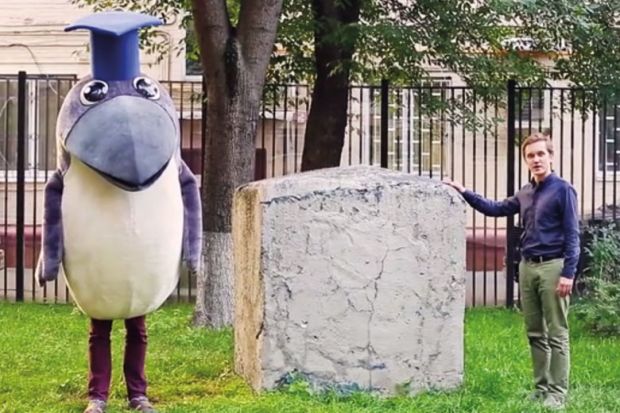Being unpaid, unloved and unknown for their troubles, anonymous peer reviewers must often feel they have one of academia’s most thankless jobs.
But a Russian sociologist is hoping to change the lot of higher education’s unsung heroes by creating the world’s first monument to the anonymous peer reviewer.
Using the crowdfunding site Kickstarter, Igor Chirikov (above right), who works at the National Research University Higher School of Economics’ Institute of Education, hopes to raise $1,300 (£990) to turn an ugly block of concrete outside his Moscow employer into a fitting tribute to what he calls the “greatest heroes…in the endless war on ignorance”.
“Peer reviewers may be recognized today by obscene graffiti on researchers’ desks and walls of great universities, as well as in mean-spirited Facebook groups,” explains Dr Chirikov, who also works at the University of California, Berkeley’s Center for Studies in Higher Education.
“But your support will enable us to finally give these invisible heroes the monument they truly deserve,” he adds on the appeal’s Kickstarter page.
It follows “research” that Dr Chirikov claims shows that peer reviewers are the joint most-hated individuals in higher education alongside university administrators, just ahead of “fortune tellers” and “people in general”.
“And the unlucky reviewers have to be hated for free,” he says in a video appeal (also view below).
“Who else is going to tell hard-working researchers that they should do more experiments or add more control groups,” he says, suggesting that “somebody had to say to Einstein ‘are you sure it is not E=mc³?’”
With more than $1,000 raised so far, it looks as though Dr Chirikov and his HSE Moscow colleagues will comfortably hit their fundraising target, which will be used to pay a sculptor to chisel the square block of concrete into a large dice.
On each of the dice’s visible sides will be painted “accept”, “minor changes”, “major changes”, “revise and resubmit” and “reject” – a nod to some of the apparently random recommendations made by some reviewers.
The tongue-in-cheek project has won some high-profile support, with two Nobel prize laureates (Eric Maskin, who won the economics prize in 2007, and graphene inventor Sir Andre Geim, who won the physics prize in 2010) backing the project.
Several academics have also paid $60 to have the name of their research paper appear on the stone, while those paying $25 will get a souvenir replica dice.
“This monument will not be just a funny square-shaped block in front of our university building…[but] will add a layer of genuine mysticism to the world of peer review and researching,” says Dr Chirikov.
“Researchers from across the world will visit to touch the 'accept' side in the hope that the gods of peer review will smile down upon them,” he adds, claiming that peer reviewers “may view the monument as a place of worship”.
Register to continue
Why register?
- Registration is free and only takes a moment
- Once registered, you can read 3 articles a month
- Sign up for our newsletter
Subscribe
Or subscribe for unlimited access to:
- Unlimited access to news, views, insights & reviews
- Digital editions
- Digital access to THE’s university and college rankings analysis
Already registered or a current subscriber? Login








